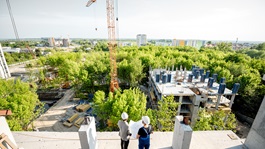This article was originally published by RenewEconomy and is reproduced with permission. Read full article
by Giles Parkinson, Editor of RenewEconomy
At a time when energy storage is the talk of the renewables sector, the use of large-scale pumped hydro to store excess electricity generation has been touted by some as a cheaper and easier alternative to batteries to complement an increasingly distributed grid.
In Australia, NSW-based company, Genex Power, hopes to test this theory via plans to convert an abandoned Queensland goldmine into one of Australia’s largest pumped hydroelectric storage plants.
The $280 million, 330MW Kidston Pumped Storage Hydro Electricity Project proposes to transform the disused Kidston gold mine in northern Queensland into a large-scale hydroelectric power plant, that will store excess renewable electricity generation and then sell it directly into Australia’s National Electricity Market during times of peak demand.
It may also have a 150MW solar plant on the old mine site too, with a new proposal to build a large solar PV array to complement the pumped storage.
Genex executive director, Simon Kidston, believes pumped storage hydro generation is making a comeback in places like the US because it is the most efficient at being able to store power at a time when solar and wind generation are expanding.
As Kidston notes, it’s a well and truly mature technology: the model they will use in Queensland has been around for more than 100 years, with more than 1,000 examples in use globally and three in Australia.
Like the Tumut 3 section of the Snowy Hydro operations, pumped hydro is based on the “water at height” principle where the reservoirs have a large height differential.
This makes it particularly well suited to the Australian energy landscape, with its multitude of retired (and soon-to-be retired) mine sites.
In Victoria, for instance, it has been suggested that the Latrobe Valley open-cut brown coal pits could be converted to PHES service once they reach their use-by dates, with below-sea-level mine pits used as lower ponds, and existing cooling water reservoirs used as upper ponds.
Of course, a Latrobe Valley PHES facility would also be ideally located beneath the major electricity transmission lines that supply the Melbourne market.
And while the Kidston mine, 270km north-west of Townsville, does not quite have that same advantage, it does have some of the key characteristics required for a pumped storage power project, including two deep, adjacent pits.
“The original mine site has two pits 400 metres apart, with an ideal size and depth,” said Genex managing director Michael Addison.
“Capital expenditure requirements are comparatively low, as the site benefits significantly from mine and electricity infrastructure already in place as well as existing permits. From its time as an operating mine, the Kidston project benefits from having numerous existing approvals in place and a clear approvals pathway.”
To test this potential, Genex – which launched an initial public offer in June ahead of listing on the Australian Securities Exchange (ASX) in July – has engaged Hydro Tasmania offshoot, Entura, to conduct a feasibility study into the proposal.
Entura will also oversee subcontracted tasks, including geotechnical investigations and a bathymetric survey, and will manage environmental and planning approvals for the project site, including specialist reports and community consultation.
“Entura is a world leader in the planning, design and construction of hydro power stations and we are pleased to have engaged them to manage the bankable feasibility study process,” said Addison.
“Initial engagements… have been very positive and we look forward to working with the Entura team, which has already indicated scope for improvements on the initial project design. The Genex Board will work closely with Entura to deliver a bankable feasibility study on budget and is on track to complete the work by 30 June 2016.”





